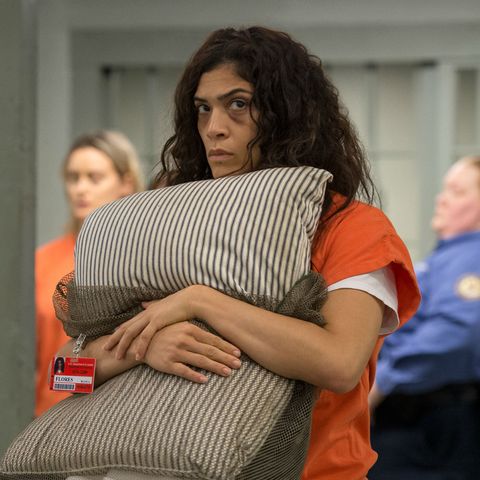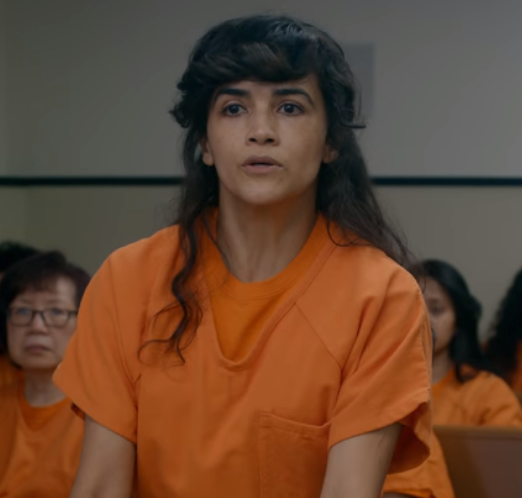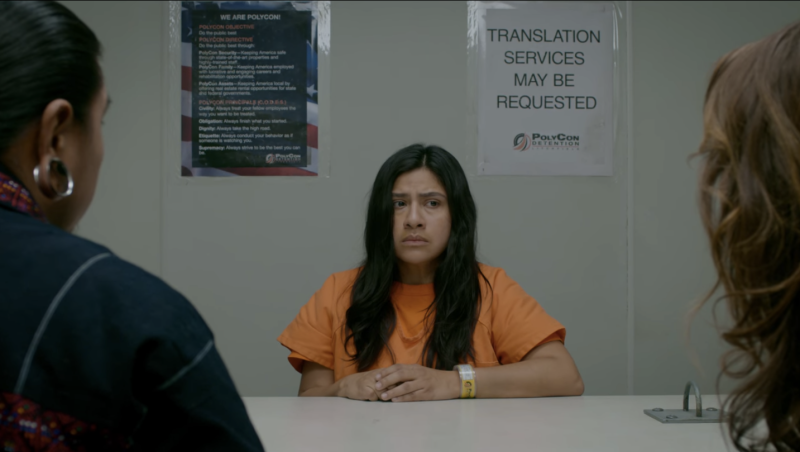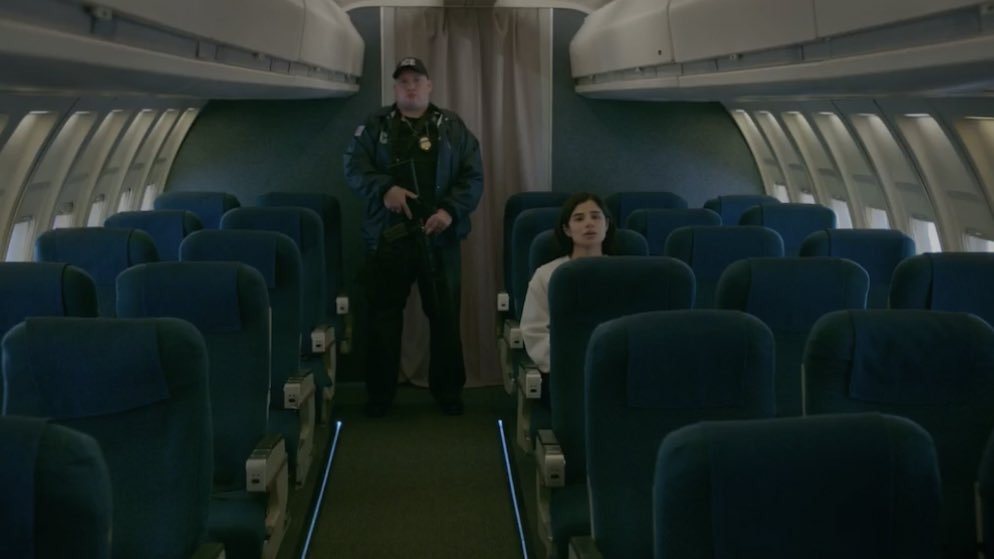
The Netflix series Orange Is the New Black (OITNB) has undoubtedly shined a light on the US prison-industrial complex through a diverse web of characters. Inmates, guards and administrators alike have been shown as the complex people they are - neither good nor bad, or perhaps both - but always human, trapped in an inhumane system. But OITNB has also been charged with exploiting the tragedies that disproportionately affect people of color and members of the LGBTQ community. Season 7, the final season for the ground-breaking show, begins with Litchfield Prison, already run by the private for-profit company PolyCon, contracting with ICE to house immigrant detainees.
The series explores a number of issues such as the lack of mental health care in prison, lack of addiction treatment, the challenges that come with parole, and the lack of re-entry services. But the lens for season 7 is most definitely immigration. We see the profit motive within private prisons taken to a whole new level through Polycon’s partnership with ICE. Even the show’s writers and producers were shocked by what they found when they began researching for this season. They visited Adelanto Immigrant Detention Center in Adelanto, CA and producer Carolina Paiz said:
"We know prisons and we imagined it was going to be like camp, like a minimum-security prison, but looser than that…What shocked us was that it was no different than a maximum-security prison, except that they have less rights. They have no right to an attorney. They have no right to a phone call. It was the most horrifying realization for people who already have worked within that world to realize that it gets darker.”
With this research, the show seamlessly weaves the stories of the characters, each dealing with very different elements of US immigration policy. We see familiar characters we have gotten to know over the years leave the prison system only to end up in immigrant detention, where we then meet new characters who have also been caught in the government’s complex web.
Let’s take a look at a few of those characters and see what insight each can offer about immigrant life in detention.
BLANCA

Blanca’s story illustrates the interplay of the US criminal system and immigration system. Blanca is granted early parole from Litchfield after her lawyer recommends she take a plea deal. A hopeful scene shows Blanca waiting to leave and her partner waiting outside for her with flowers, but the scene takes a turn as Blanca is separated into a line heading not for freedom, but to an ICE bus. It turns out her Green Card has been revoked due to her guilty plea. Her lawyer’s advice came with no regard for what that would mean for her immigration status. This outcome is a routine occurrence, given a system in which criminal lawyers who don’t know about immigration law give bad advice that can have devastating consequences. Blanca’s story is actually one of the few hopeful ones, as she learns how to defend herself in her own deportation proceedings and successfully argues she had bad legal representation when she pled guilty. This gives her enough time to find adequate legal help and eventually secure her freedom.
KARLA

Karla illustrates the challenges faced by an estimated 16 million people in the US, families with mixed immigration status. She is an undocumented widow and her two sons are US born citizens. When she is placed into deportation proceedings, her sons are placed in foster care, but she is unable to communicate with them because the foster home cannot accept calls from a prison. As the scene plays out, Karla argues that she can’t possibly take her boys back to her hometown in El Salvador where gang violence is pervasive. The judge replies that her children are not in deportation proceedings; she is. She passionately replies that she is their mom and their only parent. The judge then states that she doesn’t have custody of her children (because she was detained by ICE and they were forced into foster care) and that they can be adopted. Karla’s story shows how family separation is not just something happening at the border, but is something that happens throughout the country everyday.
President Obama’s proposed Deferred Action for Parents of Americans, or DAPA, could have prevented Karla’s deportation. According to reports, an estimated 3.6 undocumented immigrants would qualify for DAPA, which would prevent the kind of separation Karla and her boys face.
SANTOS

Santos’ storyline illustrates the need for improved language access for detained migrants. She speaks K’iche’, an indigenous language and the most common language spoken in Guatemala after Spanish. Prison guards turn to other detainees for translation but no one else at Litchfield speaks K’iche’. They yell at her to speak English, or at least Spanish, but no effort is made to find her a translator. Finally, an administrator provides a translator and discovers that she desperately needs medical care, care that is denied. In 2012 the Department of Homeland Security “committed to implementing Executive Order 13166 to ensure that all people, regardless of the language they speak, have ‘meaningful access’ to DHS’ programs and services.” This is clearly not happening. In December 2018 alone, 2 children from indigenous Maya communities died in custody and reports point to language barriers causing a delay in medical attention resulting in their deaths.
MARITZA

Maritza grows up thinking she was born in US. When she gets caught in an ICE raid she tells officers she is a US citizen, but when she tries to prove her citizenship, her mother reveals that she was actually born in Colombia. Maritza’s case is placed into an expedited removal process when she is found to be sharing an immigration hotline with fellow detainees. (The real hotline on which this is based is run by the group Freedom for Immigrants was shut down by ICE since the airing of OITNB). Expedited removal is a process that was created in 1996 to allow low-level immigration officials to deport individuals apprehended within 100 miles of the border who had entered within the last two weeks. Trump has greatly expanded its reach and use. Maritza does not see a judge and has no chance to argue her case; she is just deported with nothing to a country she doesn’t even remember. The final scene of Maritza’s story is the one of the most powerful in the season.
There are other haunting scenes like Shani being dragged out of the center, Karla being left in the desert, little kids defending themselves in court. Yes, OITNB is just a show, and sure, it’s Hollywood. But OITNB tries to make real the stories that are playing out in communities across the country everyday. So, does OITNB exploit these tragedies or shed light on them? I would argue it does both.
Maybe the real answer to the question lies in our response to the show. Do we turn off the TV and thank God that it’s not happening to us. Or do we get up and do something about it?

Comments
Susan Ring (not verified)
It was so easy to think that was reality when it wasn't.
I do not have a lot of money and do not live near the border.But getting rid of Trump is the only way I think all this might end.
I just become ill knowing so much that is true about what is happening at the border!!